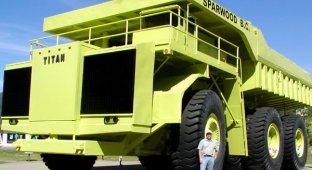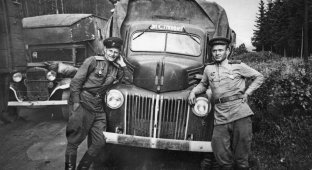MAZ 500 series: Soviet "long-range" (23 photos)
In order to create a long-haul truck, you must first make it somehow. Only then, through trial and error, arrive at the intended goal. Which, in fact, was done 50 years ago at the Minsk Automobile Plant

In 1965, serial MAZ-500 trucks began rolling off the assembly line of the Minsk Automobile Plant. Progressive in all respects, the vehicle had a layout with a cabin over the engine, an optimal ratio of payload to the truck’s own weight, and good fuel efficiency due to the installation of a YaMZ-236 engine with a power of 180 hp. With. At the same time, the plant is assigned a role in the production of heavy diesel trucks capable of operating on first category roads, allowing an axle load of 10 tons, with the ability to tow a trailer. This fully complied with the requirements of GOST 9314-59 for trucks falling into group A with a permissible load on a single axle of up to 10 tons, and on a twin bogie - up to 18 tons.
Let’s ignore the difficulty with which this machine made its way onto the assembly line; so much has already been written about this; let’s focus on two key points that influenced the further course of events.
First. This is what Mikhail Stepanovich Vysotsky, who held the post of chief designer at that time, set the goal of launching a modernized car into series every five years, and a new model every ten years. At the same time, his words did not differ from his deeds. The MAZ-500 had just entered the production line, and the factory workers were already beginning to figure out what they would end up with in the near future. To begin with, it was planned to modernize the produced model based on the results of feedback from operators. So, already at that time, the plant’s portfolio contained outlines of the future MAZ-500A.

The second, perhaps the most important circumstance. The chief designer understands that transportation volumes are constantly increasing, and with them the need for rolling stock, and as a result, there will be an additional need for drivers. However, he is not satisfied with the extensive course of events. He sees a solution to the problem in the creation of trucks and road trains with increased carrying capacity. It is with their help that transportation efficiency can be ensured. Therefore, in the strategic plan, the emphasis is on them.
And by the end of 1965, not only a promising type had been developed, but also prototypes of road trains with increased carrying capacity had been created. In addition to them, there were also search models.
The first type included a MAZ-510 heavy-duty truck for working with a trailer, a MAZ-504V two-axle truck tractor, a MAZ-516 three-axle heavy-duty truck with a third supporting rear axle, also for working with a trailer; a three-axle truck MAZ-514 for working as part of a road train and a three-axle truck tractor MAZ-515 for working with a semi-trailer. Now let's talk more about the models themselves.
MAZ-510
MAZ-510 with trailer MAZ-886 (1965)

This is a flatbed truck with increased carrying capacity for working with the MAZ-5210A (5205A) trailer on intercity routes. It should be noted that experimental vehicles already existed under this index, in particular dump trucks with a simplified single-seat cabin, which, however, never went into production. The MAZ-510 is often confused with another representative of the large Maz family - the long-wheelbase modification of the MAZ-500G. The cars did not differ so much in their platforms as they had different weight categories. MAZ-500G (8 t capacity) was intended for transportation of long cargo or use as a chassis for the installation of various superstructures (at least one of its varieties is known - the CHAR-3-500G refrigerator). MAZ-510 (load capacity 9 tons) was assigned to work as part of a road train on intercity routes with semi-trailers using dollies: two-axle MAZ-5210A and three-axle MAZ-5205A. In the first case, the road train was designed to transport 24 tons (9+15), in the second - 27 (9+18). At the same time, the car was supposed to be equipped with an engine with a power of 200 to 240 hp. With. Since there was not yet a serial unit of such power in sufficient quantity (the 240-horsepower YaMZ-238 was just being introduced into production, and besides, there were plenty of other contenders for it), the truck was shelved. The MAZ-510 can well be considered the prototype of the second wave of modernization - MAZ-53352.
MAZ-53352 with trailer MAZ-8378 (1973). It was in this form that the car hit the assembly line.

Only by 1973 did the MAZ-53352 acquire real features. The truck is equipped with a YaMZ-238E engine with a power of 265–270 hp. pp., 8-speed gearbox and a MAZ-8378 trailer specially designed for it. However, it would be another three years before this long-haul truck would hit the assembly line (February 1976). And a year later, a cab from the MAZ-5335 family will be installed on the truck. Subsequently, it will be replaced by the MAZ-53361, but now this niche is filled by the MAZ-5340 family.
MAZ-53352 with trailer MAZ-8378 (1977)

MAZ-516
Since further increases in load capacity involved the use of vehicles with added axles, three-axle vehicles were included in the type. However, at the first stage, difficulties arose with them again, mostly of an “undercover” nature. Opponents referred to the fact that the plant would not be able to take the new direction, and that triaxles were made by KrA3. Nobody took into account that an off-road KrAZ is one thing, a long-haul truck is completely different. We managed to defend the direction, but it developed with great difficulties.

The first step was the use of a third trailing axle on MAZ trucks in order to increase load capacity. The MAZ-516 became just such a truck. In its original version, it was designed to transport 15 tons. As part of a road train, the carrying capacity increased to 24 tons through the use of a MAZ-886 trailer (load capacity 9 tons). In order to maintain the necessary operating parameters, the car was also supposed to be equipped with a 200–240 hp engine. With.

MAZ-516 (1965) with lowered and raised trailing axle

At the same time, the mass utilization factor, that is, the load capacity per ton of its own weight, was 1600 kg. A very worthy indicator for the Soviet automobile industry of that time. The third trailing axle made it possible to better utilize traction force, increase the vehicle's load capacity and at the same time reduce the axle load, which was important for preserving roads. The axle was equipped with a hydraulic lifting mechanism with pneumatic control from the cabin. Since the carrying capacity has increased, and therefore fuel consumption, an additional fuel tank has been provided. At the same time, another important task was solved - saving fuel and tires when driving empty, by hanging the rear axle.
The first samples were collected already in 1965. In January of the following year, the plant began interdepartmental testing of this truck. Most likely, vehicles with YaMZ-236 engines were used for testing. There were no others, given all the conflicts happening around. Naturally, finishing the truck took some time. Only by the end of 1968 were all the comments eliminated, and the vehicles again passed interdepartmental tests. 1969 was marked by the completion of acceptance tests and the assembly of the first industrial batch.
Since the power of the YaMZ-236 was clearly not enough to work with a trailer, the first MAZ-516s were operated as “singles”, first with a carrying capacity of 14 tons, and then 14.5. A year later, the MAZ-516A appeared, since a modernized model of the base MAZ-500A truck was put on the assembly line, and the pre-production MAZ-516 was already unified with the new model.
MAZ-516A (1970)

There was only one small thing left to do - install a new cabin. As you can see, Vysotsky kept his word - five years later a modernized model appeared.
The 240-horsepower MAZ-516 engine with a carrying capacity of 16 tons, as well as the ability to work with a trailer, only gained in June 1973. Then the first industrial batch of MAZ-516B was produced. The MAZ-516 will undergo its last modernization in 1977, when the MAZ-5335 cab is installed on it.
MAZ-516B with trailer MAZ-886B (1973). The first industrial batch was produced in this form.

A small incident arose from a photo of the first MAZ-516. Most likely, it was mistakenly passed off as a full-fledged three-axle MAZ-514 for only one simple reason - the third axle was not hung. No one paid attention to the fact that the first MAZ-516 had reduced sides of the cargo platform, while all MAZ-514 were initially equipped with full-fledged onboard platforms.
MAZ-516B (1977)

The MAZ-516B was subsequently replaced by the MAZ-6301, but now the MAZ-6310 is present in the factory program.
MAZ-520
But there were other variations on the triaxial theme. For example, a search model of a truck tractor for working with a semi-trailer (MAZ-5205) with a total weight of up to 25 tons with two front steered axles. We must pay tribute, it was a fashionable trend in those years to create trucks with two steered front axles. It did not bypass MAZ either. This truck tractor, according to the developers themselves, was copied from the Mercedes-Benz LP333 and the like.
The purpose of creating the MAZ-520 was to increase the load capacity of the road train without increasing the load on the standard serial front axle. However, with a permissible axial load of 10 tons, it was not possible to significantly increase the load on the saddle, while the design became significantly more complicated compared to the simpler, but also less load-bearing MAZ-504. There were other negative aspects regarding weight distribution and handling.
After a series of tests, the factory workers abandoned this decision as unpromising and were right, since this trend quickly faded away in Western Europe, at least in the form in which it existed at that time.
MAZ-516 and MAZ-520 were only the first steps on the path to full-fledged three-axle heavy-duty trucks. By the end of the same 1965, they were also created: a car with an onboard platform and a truck tractor.
The three-axle design with two drive axles in the rear bogie was perfectly suited to Russian reality with its disgusting roads and low branching, which during the tests only convinced the developers of the correctness of the chosen path.
MAZ-514
The MAZ-514 onboard main tractor for working with the MAZ-5205A trailer was a three-axle truck with a bogie drive on both axles. As part of a road train, it could transport up to 32 tons (14+18) with a total weight of 48.7 tons. Moreover, the middle bridge was walkable. Initially it was assumed that the road train would be equipped with engines with a capacity of 240–270 hp. With. However, Yaroslavl engine builders were late in fully developing the YaMZ-238, and the 236th was completely ineffective for this road train.
MAZ-514 with trailer MAZ-886 (1965)

But it seems that in January 1966, a car with just such an engine was tested. And with the suspension it was not so simple. The rear bogie originally had Timken/Hendrikson type suspension. It turned out to be frankly raw.
At the turn of 1968–1969. The car has been significantly redesigned. First of all, the chassis was reconfigured. If at first the arrangement of fuel tanks, batteries and a spare wheel was akin to the MAZ-500, then on the cars of the new series they were swapped. By the way, this fully applies to the chronology of the creation of the MAZ-516. Subsequently, this rearrangement will take place more than once.
MAZ-514 after chassis reconfiguration (1969)

By 1971, the final decision on the MAZ-514 had been reached. The car already had a YaMZ-238 engine with a power of 240 hp. s., but it was still not enough for full-fledged work as part of a road train. The load capacity of the road train had to be reduced to 23 tons (14+9). Among the significant differences of the truck, it is worth noting the presence of an 8-speed gearbox, a through middle axle and a balancer suspension in the rear bogie.
MAZ-514 (1973). This is how carriers saw it after it was launched into series

By the time the first industrial batch was released in 1974, it was still possible to equip it with a more powerful supercharged engine YaMZ-238E with a capacity of 270 hp. With. Most likely, what this truck did not see was the MAZ-5335 cab. The plant was already full of the MAZ-5336 family.
One of the MAZ-514 variants with a MAZ-5205A semi-trailer on a dolly (1974)

After some time, the MAZ-6303 appeared in the production program, now it is replaced by the MAZ-6312.
MAZ-515
By and large, the same can be said about the MAZ-515 long-haul truck tractor, since it underwent the entire test cycle together with the MAZ-514.
MAZ-515 with an experimental semi-trailer MAZ-941 (1965)

The road train was designed to transport 30 tons with a dead weight of 46.7 tons. Initially, it was supposed to use a 2.5-PP three-axle semi-trailer, but the vehicle was sent for testing with a prototype of the MAZ-941 semi-trailer. The engine for this tractor was set at 320 hp. With. But it’s one thing to set parameters, another thing to have the necessary units available. Most likely, only in the early 1970s the car acquired real shape, however, just like the MAZ-514.
By the time the first industrial batch was released, already under the designation MAZ-515B, it was equipped with a YaMZ-238N supercharged engine with a power of 300 hp. With. This was somewhat less than originally planned. Therefore, the load capacity of the road train was reduced to 25 tons.
MAZ-515B with MAZ-941 semi-trailer (1973). This is how the car arrived at the carriers.

Despite the fact that the vehicle began to be mass-produced, work continued on layout solutions (fuel tanks, batteries, remote air filter, receivers). We tried to play with installing newfangled lighting equipment, equipping with air conditioning, etc. In 1974, at an exhibition dedicated to the 60th anniversary of the domestic automobile industry, a tractor with a cab from the MAZ-5335 was shown. And this is three years before the MAZ-5335 family was put on the assembly line!
One of the MAZ-515B variants (1973)

By the way, the long-range “500th” has also significantly improved the cabin interior. New instrument panel, sprung, with seat height adjustment; soft upholstery with thermal and noise insulation, sun visors, a dining table, window curtains, sleeping places with individual lighting devices, a heater, handrails - everything was designed to provide comfortable conditions on long trips.
“Exhibition” MAZ-515B with a MAZ-941 semi-trailer (1974)

With the transition to the new MAZ-5336 family, the MAZ-6422 subsequently entered the production line, now it has been replaced by the MAZ-6430.
MAZ-504V
While the road network, or rather its quality, left much to be desired, objectively three-axle vehicles were preferable. But with the improvement of the situation, as well as access to international transportation, the need for two-axle mainline tractors arose.
MAZ-520 with an experimental semi-trailer MAZ-5205 (1965)

The initial type of such a vehicle was provided - MAZ-504V with a MAZ-5205 semi-trailer with a carrying capacity of 18 tons. It was supposed to be equipped with a YaMZ-238A engine with a power of 215 hp. With. However, it is unknown whether such a car was assembled in 1965.
MAZ-520 during road tests (1965)

Only in 1969 did this index appear again in factory documentation. The load capacity of the road train was increased to 20 tons, simultaneously installing a more powerful engine - YaMZ-238 (240 hp). Various tests lasted about three years, and only at the end of 1972 the road train entered the assembly line. The first industrial batch was released. However, it was not destined to work on international routes - it lacked both power and carrying capacity. Everything was limited to intercity transportation.
In 1977, the tractor was modernized, at the same time installing a cabin from the MAZ-5335 family. During the same period, there was an attempt to improve the characteristics of the tractor by developing the MAZ-5428. The successor had higher power due to the installation of a YaMZ-238P supercharged engine with a power of 280 hp. With. and an 8-speed gearbox. The load on the fifth wheel coupling was also increased. The total weight of the road train increased to 33 tons. But this did not save the situation. The car remained experimental.
MAZ-504V with semi-trailer MAZ-5205A (1970)

In addition, work on the new MAZ-5336 family was in full swing at the plant. A year later, the new generation three-axle highway MAZ-6422 appeared. The two-axle model MAZ-5432 was also on the way, and it actually ruined the MAZ-5428. By the way, this branch can well be called the pedigree of the current MAZ long-haul tractors represented by the MAZ-5440 model.
It's time to sum it up. The chief designer of MAZ, Mikhail Stepanovich Vysotsky, practically kept his word, naturally, adjusted for the stagnation that had occurred in the Soviet economy. He and his team created a main line at MAZ 50 years ago and exactly 5 years after the MAZ-500 was put into production, they modernized it (MAZ-500A). And although in 1975 we did not see a new model (some of the prototypes of the MAZ-5336 family are dated 1973), in 1977 the transitional model MAZ-5335 appeared on the conveyor, and a truly new car in the form of the MAZ-6422 appeared in 1978 began her run.
MAZ-504V with semi-trailer MAZ-9397 (1977)

And then the school began to work. Thanks to her, Perestroika and a number of other prototypes appeared. Starting with the MAZ-500, Minsk residents have created three generations of cabins, although not world-class, but quite decent, and this is worthy of respect.























